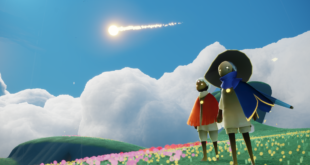Point and click adventures regularly come in and out of vogue. Part of it is nostalgia of course, with the recent run of Double Fine remasters of LucasArts games, but sometimes it is the perfect vehicle to tell a story. After a successful Kickstarter funded the game’s development, Memoranda will be released on January 25th. Inspired by the works of Huraki Murakami, this lovingly hand animated game has a touch of the weird and wornderful about it. To find out more, we spoke to Sahand Saedi, game desinger at Tehran based Bit ByterZ, to talk about the project.
What drew you to a 2D point and click style of game, and what inspirations were behind the gameplay choices?
I began playing video games when I was a teenager with titles by LucasArts, and the one that blew my mind was Day of the Tentacle. I enjoyed that title so much that point & click adventures became my favourite genre. I always thought that making a video game needed a big team, but when I played Machinarium in 2009, and read that a very small team made it, I realised it could be possible to make a video game with just three or four people.
What was it about Murakami’s short stories that inspired you to conceive the game?
The day me and my friends gathered to talk about making a video game, two of us were reading Blind Willow, Sleeping Woman at the same time without knowing the other person was reading the same book. We talked for a few minutes and both of us said that it might not be a bad idea to try and make a game by using Murakami works. His stories have the things that are necessary for making an adventure game, like strange characters, magical atmosphere, clues, etc.
Being a kickstarter project, what difficulties did you face in the development before crowdfunding?
Before launching our Kickstarter campaign, Memoranda was intended to be a small game and we also didn’t expect to get funded. We just spent about $9,000 dollars on the project, with three people working on it. So we didn’t have any money to pay for voice artists, composing more music, and making Memoranda something close to a standard point & click game. We even tried to do the voice overs ourselves, but the results were terrible.
Also no-one knew about us except our friends and fans on Facebook, and there was no news coverage about the game. If we weren’t featured by Kickstarter on the first page I don’t think it would have been a successful campaign.
How has development been since the crowdfunding?
After crowdfunding more people knew about us, so we thought about making the game bigger, with more characters and puzzles. We found some voice artists during the campaign and one of the best things was publisher Digital Dragon contacting us after that, so now we are working together to finish and publish the game.
We added some backers as characters to the game and because I didn’t want them to be just characters standing somewhere and talking a few sentences, I had to change lots of parts, which changed the game a bit more than what we thought. We re-programmed nearly the whole game to make it more stable and smoother.
That’s why we have had an 8-9 months delay, but we are thankful that backers understand the situation for indie developers.
The art is wonderful. How did you go about realising the concepts in your mind, from the stories, and putting them in to that form?
At first I had a dark minimalistic art style in mind, but thanks to the game artist, Maliheh Rahrovan, it changed to what you can see today. We didn’t design the game art in the usual way – I just told Maliheh a few lines of the story behind each character, his/her personality and the important objects in each scene, and after a few days she presented her work, which was acceptable in most cases and very close to what I was imagining. It was our first experience, and of course we won’t go the same way in future projects, but for Memoranda it worked.
A game like this is all about atmosphere and not revealing too much. Tell us about how that process started and got to where it is now?
The magical realism in Murakami’s stories was the key element that helped us create the atmosphere – I just selected some storylines and characters from lots of different stories and blended them into one. That’s why the game might be more interesting for people who have read Murakami’s works.
Creating puzzles for a game like this must be a difficult juggling act. Tell us about how you designed these and what inspirations you had.
Yes, it was difficult for me to create puzzles as it was my first attempt, but it was really a fun process because I completed the story gradually. For example, I was reading a new short story and found a character interesting; then I decided to put them in the game. So I began creating some small puzzles, writing short dialogues, adding objects around the new character to make things ready for their presence. Most puzzles came to my mind while connecting stories and characters together.
Old and some new point & click games were my inspirations; the ones where you have to talk to people, interact with objects, look at things carefully and think about their connection to other things.
What’s next for you and the game?
The game will be released on 25 January 2017, and then I’ll be free to work on new games. We also want to make an iOS version of the game, but that may take some time. In this project we learned lots of things and we are sure that we won’t make the same mistakes again. Beside small mobile games, a friend and I are writing the script for a minimal 3D point & click adventure game.

 MCV/DEVELOP News, events, research and jobs from the games industry
MCV/DEVELOP News, events, research and jobs from the games industry


